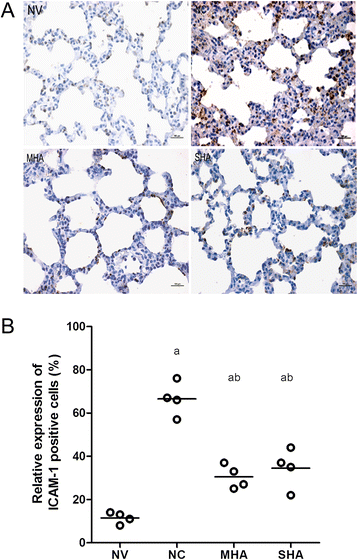Comparison of the effects of moderate and severe hypercapnic acidosis on ventilation-induced lung injury
- PMID: 25924944
- PMCID: PMC4443663
- DOI: 10.1186/s12871-015-0050-8
Comparison of the effects of moderate and severe hypercapnic acidosis on ventilation-induced lung injury
Abstract
Background: We have proved that hypercapnic acidosis (a PaCO2 of 80-100 mmHg) protects against ventilator-induced lung injury in rats. However, there remains uncertainty regarding the appropriate target PaCO2 or if greater CO2 "doses" (PaCO2 > 100 mmHg) demonstrate this effect. We wished to determine whether severe acute hypercapnic acidosis can reduce stretch-induced injury, as well as the role of nuclear factor-κB (NF-κB) in the effects of acute hypercapnic acidosis.
Methods: Fifty-four rats were ventilated for 4 hours with a pressure-controlled ventilation mode set at a peak inspiratory pressure (PIP) of 30 cmH2O. A gas mixture of carbon dioxide with oxygen (FiCO2 = 4-5%, FiCO2 = 11-12% or FiCO2 = 16-17%; FiO2 = 0.7; balance N2) was immediately administered to maintain the target PaCO2 in the NC (a PaCO2 of 35-45 mmHg), MHA (a PaCO2 of 80-100 mmHg) and SHA (a PaCO2 of 130-150 mmHg) groups. Nine normal or non-ventilated rats served as controls. The hemodynamics, gas exchange and inflammatory parameters were measured. The role of NF-κB pathway in hypercapnic acidosis-mediated protection from high-pressure stretch injury was then determined.
Results: In the NC group, high-pressure ventilation resulted in a decrease in PaO2/FiO2 from 415.6 (37.1) mmHg to 179.1 (23.5) mmHg (p < 0.001), but improved by MHA (379.9 ± 34.5 mmHg) and SHA (298.6 ± 35.3 mmHg). The lung injury score in the SHA group (7.8 ± 1.6) was lower than the NC group (11.8 ± 2.3, P < 0.05) but was higher than the MHA group (4.4 ± 1.3, P < 0.05). Compared with the NC group, after 4 h of high pressure ventilation, the MHA and SHA groups had decreases in MPO activity of 67% and 33%, respectively, and also declined the levels of TNF-α (58% versus 72%) and MIP-2 (76% versus 60%) in the BALF. Additionally, both hypercapnic acidosis groups reduced stretch-induced NF-κB activation (p < 0.05) and significantly decreased lung ICAM-1 expression (p < 0.05).
Conclusions: Moderate hypercapnic acidosis (PaCO2 maintained at 80-100 mmHg) has a greater protective effect on high-pressure ventilation-induced inflammatory injury. The potential mechanisms may involve alterations in NF-κB activity.
Figures





Similar articles
-
Hypercapnic acidosis attenuates ventilation-induced lung injury by a nuclear factor-κB-dependent mechanism.Crit Care Med. 2012 Sep;40(9):2622-30. doi: 10.1097/CCM.0b013e318258f8b4. Crit Care Med. 2012. PMID: 22732277
-
Does hypercapnic acidosis, induced by adding CO2 to inspired gas, have protective effect in a ventilator-induced lung injury?J Korean Med Sci. 2005 Oct;20(5):764-9. doi: 10.3346/jkms.2005.20.5.764. J Korean Med Sci. 2005. PMID: 16224149 Free PMC article.
-
The Effects of Lung Protective Ventilation or Hypercapnic Acidosis on Gas Exchange and Lung Injury in Surfactant Deficient Rabbits.PLoS One. 2016 Feb 3;11(2):e0147807. doi: 10.1371/journal.pone.0147807. eCollection 2016. PLoS One. 2016. PMID: 26840779 Free PMC article.
-
Effects of hypercapnia and hypercapnic acidosis on attenuation of ventilator-associated lung injury.Minerva Anestesiol. 2011 Jul;77(7):723-33. Minerva Anestesiol. 2011. PMID: 21709659 Review.
-
Carbon dioxide in the critically ill: too much or too little of a good thing?Respir Care. 2014 Oct;59(10):1597-605. doi: 10.4187/respcare.03405. Respir Care. 2014. PMID: 25261559 Review.
Cited by
-
Carbon dioxide and MAPK signalling: towards therapy for inflammation.Cell Commun Signal. 2023 Oct 10;21(1):280. doi: 10.1186/s12964-023-01306-x. Cell Commun Signal. 2023. PMID: 37817178 Free PMC article. Review.
-
Hypercapnia in the critically ill: insights from the bench to the bedside.Interface Focus. 2021 Apr 6;11(2):20200032. doi: 10.1098/rsfs.2020.0032. Epub 2021 Feb 12. Interface Focus. 2021. PMID: 33628425 Free PMC article. Review.
-
Management of Acute Kidney Injury in the Setting of Acute Respiratory Distress Syndrome: Review Focusing on Ventilation and Fluid Management Strategies.J Clin Med Res. 2020 Jan;12(1):1-5. doi: 10.14740/jocmr3938. Epub 2020 Jan 6. J Clin Med Res. 2020. PMID: 32010415 Free PMC article. Review.
References
-
- Dreyfuss D, Basset G, Soler P, Saumon G. Intermittent positive-pressure hyperventilation with high inflation pressures produces pulmonary microvascular injury in rats. Am Rev Respir Dis. 1985;132(4):880–4. - PubMed
Publication types
MeSH terms
Substances
LinkOut - more resources
Full Text Sources
Other Literature Sources
Research Materials
Miscellaneous

